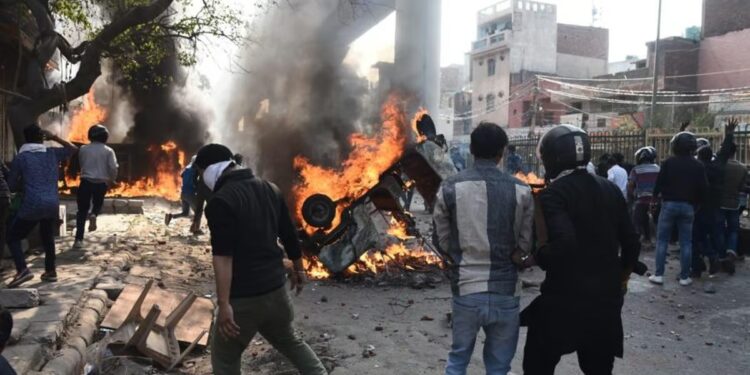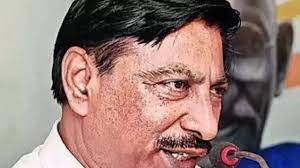What happened in the riots in North East Delhi in 2020?
Two years after being imprisoned for crimes he most likely did not commit, 40-year-old Tahir finally emerged from Mandoli Jail on a chilly January 2022 day to see his wife and kids.

“I wasn’t sure whether to be joyful or sad when I came out. Speaking on his difficult times, Tahir stated, “I’m happy that I’m now free and sorry for the trauma that my family and I had to endure throughout my captivity.
Arson, looting, rioting, and the destruction of stores and houses were all seen in the national capital, not a rural area.
During a demonstration against the Citizenship (Amendment) Act (CAA) in February 2020, communal violence occurred in the northeast of Delhi, tearing apart the city’s social cohesion. Up to 54 persons died, more than 40 of them were from the minority group.
Pankaj is now 34 years old. Four years ago, he had a wonderful life with his wife and three children. His wife is no longer with him; he says she died of sadness after his incarceration.
“In relation to the rioting, the Delhi Police pulled me up from my home on March 9, 2020. I was turned over to the Crime Branch the next day, and they went on to arrest me on charges of rioting, murder, etc. There was a line of IPC parts in the FIR when I noticed it. When asked to sign it, I declined. They assured me that this was a minor matter and that I would be released soon. Pankaj told this publication, “I never thought that this’sometime’ would cost me four years of my life.”
At last, Pankaj was freed on bond in August 2023. Pankaj said, “They caught me based on my mobile location,” when asked why he had been taken into custody. Yes, I was there in the vicinity of my home, but I wasn’t with any group. I vividly recall the protesters at the Chand Bagh flyover on February 24, shouting religious chants. I felt afraid. The youngest of my three kids was just a year old,” he said.
Pankaj said, “Those were terrible times,” recalling an incident in which a Hindu youngster was being pursued by rioters and a mosque preacher rescued him. After being stabbed, the youngster fled and went inside a mosque, where the imam kept him concealed and saved his life.”
Tahir (who was mentioned in the opening paragraph) can still clearly recall February 25, 2020, as if it were yesterday. He remembers that tragic day as the one that completely changed his life, forcing him to serve two years in prison for a crime he did not commit.
He was seen on the neighborhood’s CCTV video, which is how the Delhi police were able to file a FIR against him for rioting and arson. “I was working at my brother’s store in Mustafabad, an area touched by the unrest, when it broke out. Something was stirring on Main Street, and I decided to get over there. When I got to the main road, I saw people throwing stones and setting cars on fire. I was so terrified that I withdrew right away and went home,” he added.
The cops arrived at his home two months later to conduct a non-formal investigation. Tahir said he didn’t know the cops were going to take him into custody at the moment. However, events did not unfold as he had anticipated. Tahir was then had to serve two years in jail before his innocence was established in court.
“My children’s schooling was the worst loss my family suffered during the two years of incarceration. I enrolled my kid and daughter in a reputable school in 2019 so they could get an education. But my legal battle consumed all of my cash, which hurt their schooling,” Tahir said.
Razia, Tahir’s wife, supported her husband throughout those tumultuous moments. She said that she had experienced difficulties for the previous two years. “All of the obligations piled on my shoulders at once. I had to take care of my family and handle the legal situation. I had to turn to sleeping drugs during those miserable days in order to obtain any sleep,” said Razia.
Like Tahir, Irshad was imprisoned for 13 months until a Delhi court found him not guilty. 21-year-old Irshad said he was detained because of the position of his cellphone and questioned how things could have been any different if the violence had happened close to his home.
Irshad, in spite of everything, still feels that time will cure this wound and that the 25th of February should be crossed off of calendars worldwide.
Demonstrators during altercations in northeastern Delhi in February 2020.
In 2020 Delhi riot case, three arson suspects found not guilty despite their ‘not safe’ declaration
With the approval of former President Ram Nath Kovind, the Citizenship Amendment Bill (CAB), which had been approved by both Houses of Parliament, became an Act on December 12, 2019. But as soon as it was passed, there were massive demonstrations, first in Assam and then moving to other States, including Delhi.
The Indian Citizenship Act (CAA) has been amended with the intention of granting citizenship to migrants from Afghanistan, Bangladesh, and Pakistan who were afraid of religious persecution back home faster. These migrants are members of the Hindu, Sikh, Jain, Parsi, Buddhist, and Christian communities and entered India prior to 2014. The Act did, however, expressly exclude those who were part of the Muslim community.
The center of the anti-act protests was Shaheen Bagh in southeast Delhi. In Shaheen Bagh, the ladies sat in unending protest despite Delhi’s very chilly days.
Protests against the CAA were also held in places where a sizable Muslim community dwells, such as Hauz Rani, Jama Masjid, Darya Ganj, Seelampur, Nabi Kareem, Shastri Nagar, and Sadar Bazar.
The prolonged sit-in, which resulted in a blockade (chakka-jaam) by groups that seemed disorganized but were united by anti-CAA undercurrents, had made life difficult for those who commuted every day.
On February 22, 2020, over a thousand protestors, including women, started a sit-in demonstration close to the Jaffrabad metro station. After arriving at a protest location in Maujpur Chowk one day later, BJP leader Kapil Mishra and his followers are said to have threatened to “take matters into his own hands if the police failed to disperse the protesters” from the Chand Bagh and Jaffrabad neighborhoods within the next three days.
Subsequently, protesters supporting and against the CAA clashed at Chand Bagh, Babarpur, Maujpur Chowk, and Karawal Nagar. Shops were wrecked and vehicles were ruined. Tear gas and lathi charges were deployed by the police to break up the gathering, but the violence persisted, with rioters destroying both persons and property.
53 individuals were murdered in the rioting, with the Muslim minority accounting for two thirds of the casualties. Among the deceased were more than a dozen Hindus. According to reports, the victim may have been stabbed, shot, or caught fire.
Open drains also included a number of corpses. Hospitals were harboring hundreds of injured when the fighting came to a close. Two years later, an independent report by the committee of retired judges and bureaucrats acknowledged that the violence was the tragic result of a deliberate effort to further polarize the two communities rather than only being understood through the narrow lens of that fateful week in February 2020.
Demonstrate Khalid Saifi’s involvement in the riots of 20: Delhi High Court
The investigation
More than 750 FIRs have been filed by the Delhi Police in relation to the intercommunal conflicts.About twenty-four FIRs were filed at the police station in New Usmanpur; ten in Shastri Nagar; eleven in Golkulpuri; seventy-six in Dayalpur; ninety-three in Khajuri Khas; ninety-one in Karawal Nagar; five in Sonia Vihar; thirteen in Bhajanpura; twenty-six in Welcome; and seventy-nine in Jafrabad.
The Crime Branch established three Special Investigation Teams (SITs) to look into the cases. The Special Cell of the Delhi Police looked into one of the cases that was filed in an attempt to find the conspiracy behind the rioting. The northeast district, on the other hand, looked into the remaining instances.
In order to identify the accused from CCTV footage, the investigative teams used video analytics and a face recognition system (FRS). They also recovered deleted data from electronic devices, utilized geolocation to determine the accused’s whereabouts, and used drone mapping to recreate the crime scene.
Investigating the cases also included the use of DNA fingerprinting, the e-Vahan database, face recognition, cash flow analysis, and forensic teams that analyzed videos and photos from public sources using ballistic, chemical, biological, and physical analysis.
In the months that followed, the police detained close to 2,000 persons as they carried out their investigation. But were they all shown to be guilty? No, is the response.
The Delhi Police has sometimes come under fire from the courts for their “shoddy probe” into the rioting charges. Over 180 persons have been found not guilty so far, with 47 convictions. Currently, almost 1,700 defendants are free on bond.
For those who have served a few years in prison, life has changed significantly. This publication met with a number of these individuals, who were either given bail by the courts or were found not guilty, to learn more about their lives.
Umar Khalid leaves the SC bail motion in order to reapply for bail before the trial court.
Why the lengthy wait?
Attorney Salim Khan, who has handled more than 100 cases pertaining to the riots in Northeast Delhi, claims that the police have listed various accused and the same accused in several FIRs, making it difficult for the accused to get bail.
Salim’s clientele comprises ninety percent members of economically deprived households. Examining their job descriptions closely, you’ll discover that the majority of them are workers, renters, auto-rickshaw drivers, and—above all—illiterate. Their little comprehension of legal processes makes it difficult for us to interact with them in an efficient manner, Salim said.
Salim emphasized that these people lacked the resources to pay the court-imposed bail bond sums, which would have allowed their family members to be released. As a result, they launched community-based crowdfunding campaigns to gather the necessary monies and fulfill the court’s bail requirements.
According to Joy Tirkey, the deputy commissioner of police for northeast Delhi, there have been many attempts over the last four years to foster a sense of fraternity between the two groups, and as a result, there is now calm in the area.
“I have been in the northeast district for a long time—I was employed by the Crime Branch for 14 years before being sent here as the DCP. We have maintained a tight relationship with the northeast district ever since the 2020 riots. I worked on many riot instances that the Crime Branch’s SIT was looking into, and SIT is still with me, the DCP said. He said that the northeast district of Delhi is the place in need of real, on-the-ground law enforcement.
It is crucial that there be police officers present on the scene. The northeast region is not just a crime-ridden neighborhood but also a sensitive community. Twelve of the district’s fourteen police stations had reports of incidents involving intercommunal conflict, the speaker said.
He added that in order to make sure that there is always peace in the region, the police maintain frequent contact with the members of peace committees and have joint meetings with people of both groups.
Distinguished individuals
Umar Khalid, Sharjeel Imam, Safoora Zargar, Asif Iqbal Tanha, Meeran Haider, Shifa-Ur-Rehman, Gulshan Fatima, Khalid Sai, Shadab Ahmed, Tasleem Ahmed, Mohd. Saleem Khan, Athar Khan, Devangana Kalita, Natasha Narwal, and former Aam Aadmi Party councillor Tahir Hussain are the individuals against whom the riots and the “larger conspiracy” are being sued.
Customers from families with lower incomes
Attorney Salim Khan, who has handled more than 100 riot-related cases, claims that the police have listed various accused and the same accused in several FIRs, making it difficult for the accused to get bail. Ninety percent of his clientele are from households with low incomes. Salim emphasized that these people lacked the resources to pay the court’s stipulated bail bond sums.
Courts chastised police for their “poor investigation.”
Investigating the cases also included the use of DNA fingerprinting, the e-Vahan database, face recognition, cash flow analysis, and forensic teams that analyzed videos and photos from public sources using ballistic, chemical, biological, and physical analysis. As the police carried out their investigation, close to 2,000 persons were taken into custody in the next months. But were they all shown to be guilty? No, is the response. The Delhi Police has sometimes come under fire from the courts for their “shoddy probe” into the rioting charges.







